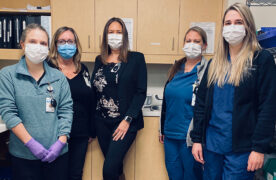By Mark McIntyre
Pharm.D.,ACPR
Antimicrobial stewardship (AMS) remains an important topic in the role of pharmacy professionals in any practice environment and is becoming increasingly so for those in community practice settings. Pharmacy Connection welcomes contributors from the Antimicrobial Stewardship Program team at the Sinai Health System and University Health Network in Toronto to share their insights and perspectives.
This is the fourth and final in their series about the role of community pharmacy professionals in AMS which reinforces important information for practitioners while providing practical tips and access to resources to support ongoing AMS efforts within our health system. In this issue, we are focusing on acute pharyngitis (sore throat).
Sore throat is one of the most common reasons for infection-related primary care assessment.1 Pain and concern about complications of bacterial infection are often the key drivers of patient presentation.2 While the vast majority (>80-90 per cent) of pharyngitis in adults is caused by viral infection, Group A Streptococci (GAS) causes up to 37 per cent of pharyngitis in pediatric patients.3 Decision aids help identify patients less likely to have streptococcal disease and thus not benefit from antimicrobial treatment.4 Despite tool availability, prescription of antimicrobials for pharyngitis that is likely viral remains common.5 In one recent study, nearly 30 per cent of those presenting for care received antimicrobials inappropriately. Of those prescribed antimicrobials, 85 percent received either the incorrect antibiotic, dose or duration. 6
GROUP A STREPTOCOCCI
Determining the etiology of pharyngitis (viral versus Group A streptococci versus other bacteria) and thus the need for antimicrobial treatment can be confusing for patients and clinicians. Generally, GAS is an acute onset “single system” disease of the pharynx and is not associated with nasal, other upper or lower respiratory or gastrointestinal symptoms.7 Assessment of uncomplicated pharyngitis is supported by the McIssac/modified Centor score (below). 8,9
| Age | Score |
|---|---|
| 3-14 | 1 |
| 14-44 | 0 |
| ≥45 | -1 |
| Symptoms | Score |
|---|---|
| Fever ≥ 38C | 1 |
| No cough | 1 |
| Red tonsils/pustular exudate | 1 |
| Anterior cervical lymphadenopathy(swollen lymph nodes in the neck) | 1 |
Limitations exist in applicability of this tool to all populations such as caregivers of young children (parents/educators) or in the setting of epidemic disease owing to a higher pre-test probability of GAS. This scoring tool should not be used if signs of complicated infection exist.
If the score is ?1, no testing or antimicrobial therapy is suggested. If the score is 2-3, testing using a rapid diagnostic test (RADT) and/or throat culture is advisable. Antibiotic therapy should be initiated if testing is positive. Note that in children, a negative RADT may prompt a throat culture for confirmation.7,10 if the McIssac/modified Centor score is ? 4, empiric antimicrobial treatment should be started with antibiotics stopped if testing is negative as noted above.
SIGNS AND SYMPTOMS OF COMPLICATED PHARYNGITIS REQUIRING URGENT REFERRAL
- Difficulty swallowing
- Drooling
- Severe unilateral neck swelling/pain
- Severe headache
- Confusion
- Skin rash
- Vital sign instability (rapid heart rate, rapid breathing, low blood pressure)
EDUCATING PATIENTS
The easiest way to avoid unnecessary testing and treatment of pharyngitis is to avoid getting sick in the first place. Proactive stewardship solutions including hand hygiene and cough etiquette serve to reduce the transmission of both bacterial and viral pathogens and reduce the incidence of sore throat. Educating your patients about the difference between sore throat and “strep throat” can highlight when a “tincture of time” is appropriate and when patients should seek medical advice.
When patients present with pharyngitis symptoms, assess severity and the likelihood for GAS using the McIssac score. If there is a low risk of bacterial infection, educate them about the anticipated duration of viral sore throat (90 per cent self-resolve in less than seven days) and self-management steps for symptomatic relief (OTC analgesics, etc.). Reinforce that antibiotics have no benefit for viral infection. Should symptoms persist or worsen, patients should seek medical advice.
When patients come with a prescription for antibiotics, confirm the indication and assess the choice of antibiotic and duration. Group A streptococci has no documented resistance to penicillin, which remains the optimal choice for the treatment of confirmed GAS pharyngitis.7 All penicillin allergies require clarification to ensure optimal therapy.11,12 Symptomatic management of pain with OTC analgesics, particularly NSAIDs, can be suggested as appropriate. Lastly, ensure the appropriate duration of antimicrobial therapy. There is an increased infection recurrence rate when patients are treated with five versus 10 days of therapy for GAS pharyngitis infection.7 Help ensure patients get the right antibiotics when they need them.
SUGGESTED TREATMENT OF SUSPECTED OR CONFIRMED GROUP A STREPTOCOCCAL PHARYNGITIS7
| Treatment | Adults/Adolescents | Children |
|---|---|---|
| 1st line | Penicillin VK 600mg PO BID x 10 days | Penicillin VK: 40-50mg/kg/day divided BID to TID x 10 days (maximum 750mg/day) |
| Alternate | Amoxicillin 1000mg PO daily x 10 days Amoxicillin 500mg PO BID x 10 days |
Amoxicillin 50mg/kg/day PO once daily or divided BID x 10 days (maximum 1000mg/day) |
| Allergy (non – anaphylaxis) |
Cephalexin 500mg PO BID x 10 days | Cephalexin 40mg/kg/day divided BID (max 1000mg/day) x 10 days |
| Allergy (anaphylaxis) | Clindamycin 300mg PO TID x 10 days
Clarithromycin 250mg PO BID x 10 days Azithromycin 500mg PO x 1 dose on day 1, followed by 250mg PO daily x 4 days |
Clindamycin 20 mg/kg/day divided TID x 10 days (max 900mg/day)
Clarithromycin 15mg/kg/day divided BID x 10 days (max 500mg/day) Azithromycin 12mg/kg x once on day 1 followed by 6mg/kg once daily x 4 days |
ADDITIONAL SOURCES:
- SHS-UHN ASP Website https://www.antimicrobialstewardship.com/upperrespiratory
- Do Bugs Need Drugs? Sore Throat http://www.dobugsneeddrugs.org/guide/sore-throat/
- Choosing Wisely Canada https://choosingwiselycanada.org/colds-flu-respiratory-illnesses-dont-rush-antibiotics/
- INESSS Pharyngitis-Tonsillitis in Children and Adults https://www.inesss.qc.ca/fileadmin/doc/INESSS/Outils/GUO/Anglo/Guide_Pharyngite-Amygdalite_EN_WEB.pdf
- CDC – Group A Streptococcal Disease https://www.cdc.gov/groupastrep/diseases-hcp/index.html
- Public Health Ontario – Systematic Antibiotic Allergy Verification – https://www.publichealthontario.ca/apps/asp-strategies/data/pdf/ASP_Strategy_Systematic_Antibiotic_Allergy_Verification.pdf
REFERENCES:
1. Harris AM, Hicks LA, Qaseem A. Appropriate Antibiotic Use for Acute Respiratory Tract Infection in Adults: Advice for High-Value Care From the American College of Physicians and the Centers for Disease Control and Prevention. Annals of internal medicine. 2016;164(6):425-434.
2. O’Connor R, O’Doherty J, O’Regan A, O’Neill A, McMahon C, Dunne CP. Medical management of acute upper respiratory infections in an urban primary care out-of-hours facility: cross-sectional study of patient presentations and expectations. BMJ Open. 2019;9(2):e025396.
3. Shaikh N, Leonard E, Martin JM. Prevalence of streptococcal pharyngitis and streptococcal carriage in children: a meta-analysis. Pediatrics. 2010;126(3):e557-564.
4. Banerjee S FC. Clinical Decision Rules and Strategies for the Diagnosis of Group A Streptococcal Infection: A Review of Clinical Utility and Guidelines. May 23, 2018 ed2018.
5. Kronman MP, Zhou C, Mangione-Smith R. Bacterial prevalence and antimicrobial prescribing trends for acute respiratory tract infections. Pediatrics. 2014;134(4):e956-965.
6. Razai M, Hussain K. Improving antimicrobial prescribing practice for sore throat symptoms in a general practice setting. BMJ Qual Improv Rep. 2017;6(1).
7. Shulman ST, Bisno AL, Clegg HW, et al. Clinical practice guideline for the diagnosis and management of group A streptococcal pharyngitis: 2012 update by the Infectious Diseases Society of America. Clin Infect Dis. 2012;55(10):1279-1282.
8. Zakhary SA, Davey C, Bari R, et al. The Development and Content Validation of a Multidisciplinary, Evidence-based Wound Infection Prevention and Treatment Guideline. Ostomy Wound Manage. 2017;63(11):18-29.
9. Akpan MR, Ahmad R, Shebl NA, Ashiru-Oredope D. A Review of Quality Measures for Assessing the Impact of Antimicrobial Stewardship Programs in Hospitals. Antibiotics (Basel). 2016;5(1).
10. Cohen JF, Bertille N, Cohen R, Chalumeau M. Rapid antigen detection test for group A streptococcus in children with pharyngitis. Cochrane Database Syst Rev. 2016;7:CD010502.
11. Blumenthal KG, Peter JG, Trubiano JA, Phillips EJ. Antibiotic allergy. Lancet. 2019;393(10167):183-198.
12. Shenoy ES, Macy E, Rowe T, Blumenthal KG. Evaluation and Management of Penicillin Allergy: A Review. JAMA. 2019;321(2):188-199.













